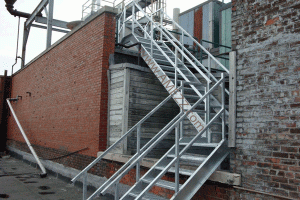Many locations have old stairs that need to fixed or replaced due to age, damage etc. Generally speaking regardless of the code in place when the original stair was made, you will need to update your stair to the current building code (IBC) when you replace stairs.
3404.1 General. Except as provided by Section 3401.4 or this section, alterations to any building or structure shall comply with the requirements of the code for new construction. Alterations shall be such that the existing building or structure is no less complying with the provisions of this code than the existing building or structure was prior to the alteration.
This becomes an issue when stairs are installed in tight locations under codes that vary greatly from today’s current International Building Code (IBC) variants.
Imagine having a 12’ high stair in place with a riser height of 9” and a tread depth of 9”. This stair would have (16) treads, 9”deep for a total run of 11’3”.
If the replacement stairs would be required to meet IBC code (adopted by all of the states) they would now need to have (20) treads, 11” deep for a total run of 18’4”. The IBC stairs would extend 7’1” further than the originally installed stairs.
The increased run and decreased slope can wreak havoc on your facilities if the original stairs stopped right before a hallway (new stairs would extend well into the hallway) or if the stairs are enclosed (new slope would cause head clearance issues with existing structure).
If the above situation applies to you don’t sweat it. The above referenced IBC code section does have an exception that may help
Exceptions:
- An existing stairway shall not be required to comply with the requirements of Section 1009 where the existing space and construction does not allow a reduction in pitch or slope.
- Handrails otherwise required to comply with Section 1009.12 shall not be required to comply with the requirements of Section 1012.6 regarding full extension of the handrails where such extensions would be hazardous due to plan configuration.
Why the exemption for stairs (and possibly ramps, though not specifically called out)? The thinking behind the exemption is that without it, stairs that need to be replaced and are not safe will be neglected and not maintained due to the inability to bring them up to current codes. It is better to have a well maintained stair meeting an earlier code than have a poorly maintained stair that doesn’t meet current codes.


This is some really good information to know if you are planning to rebuild a staircase. I didn’t realize that most states have a version of the IBC code.
It would depend on the code at time of install, and whether the stair is going to be altered or not.
Generally for residential applications we say to check with your local building department as many local statutes are created that exceed the requirements for the state building code.
Reviewing IBC 2012, 1009.4, the only change from industrial to residential applications is their exemption #4; which pertains to usage of a stairway lift and allowing it to encroach on the overall usable stair width down to a minimum width of 20″. There are no other exemptions allowing for deviation from the 44″w (for occupied loads 50+) and 36″w (for occupied loads <50 people) regardless of building classification in 1009.4.
If your question is regarding an existing stair that is undergoing alterations, 3404.1 states that "alterations to any building or structure shall comply with the requirements of the code for new construction". Section 3404.1 gives two exemptions regarding pitch and slope, and handrail extensions, but does not give any exemptions with regards to stair width.
Again though, applicable local building codes at time of original stair construction and whether or not the stairs are going to altered are going to be key for this instance.
~Brett